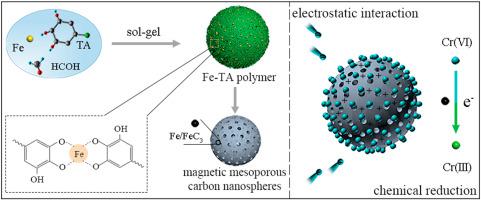Microporous and Mesoporous Materials ( IF 4.8 ) Pub Date : 2020-09-08 , DOI: 10.1016/j.micromeso.2020.110623 Gen Wang , Ge Gao , Shengjiong Yang , Zheng Wang , Pengkang Jin , Jing Wei

|
Magnetic mesoporous carbon composites are promising adsorbents for water purification. However, the sustainable synthesis of such mesoporous carbon nanospheres with controllable structures and compositions using renewable biomass as a carbon source is still a great challenge. Herein, mesoporous carbon nanospheres have been successfully synthesized via direct pyrolysis of iron-phenolic coordination polymers. Such coordination polymers are fabricated using plant phenol as a renewable carbon source and iron ions as a metal source. The resultant magnetic mesoporous carbon nanospheres show large pore size (6.7 nm), high specific surface area (512.3 m2/g), excellent performance for Cr(VI) removal with a high adsorption capacity (336.7 mg/g), fast adsorption rate (1.60 × 10−3 mg g−1 min−1) and easy magnetic separation property. In the adsorption process, Cr(VI) is first trapped on the surface of magnetic mesoporous carbon nanospheres via electrostatic interaction. Then part of the adsorbed Cr(VI) is reduced to low-toxic Cr(III) by α-Fe/Fe3C nanoparticles dispersed in carbon nanospheres. This work provides an efficient synthesis strategy for magnetic mesoporous carbon nanospheres using plant polyphenol as a carbon source, which could be used in environmental science, energy storage and catalysis.
中文翻译:

来自可再生植物酚的磁性介孔碳纳米球,可有效去除六价铬
磁性介孔碳复合材料是有希望用于水净化的吸附剂。然而,使用可再生生物质作为碳源来可持续合成具有可控结构和组成的中孔碳纳米球仍然是巨大的挑战。在此,通过直接热解铁-酚配位聚合物成功地合成了介孔碳纳米球。使用植物苯酚作为可再生碳源和铁离子作为金属源来制备这种配位聚合物。所得的磁性介孔碳纳米球显示出大孔径(6.7 nm),高比表面积(512.3 m 2 / g),优异的Cr(VI)去除性能,高吸附容量(336.7 mg / g),快速吸附速率(1.60×10 -3 毫克g-1 min -1)和易磁分离性能。在吸附过程中,Cr(VI)首先通过静电相互作用被捕获在磁性介孔碳纳米球的表面上。然后,一部分吸附的Cr(VI)被分散在碳纳米球中的α-Fe/ Fe 3 C纳米颗粒还原为低毒的Cr(III)。这项工作为使用植物多酚作为碳源的磁介孔碳纳米球提供了一种有效的合成策略,可用于环境科学,能量存储和催化。











































 京公网安备 11010802027423号
京公网安备 11010802027423号